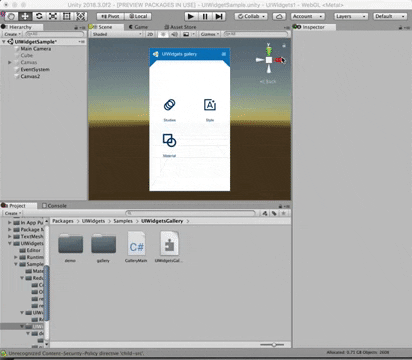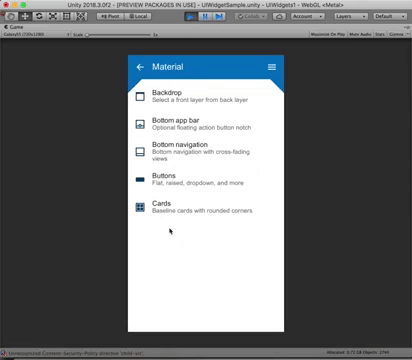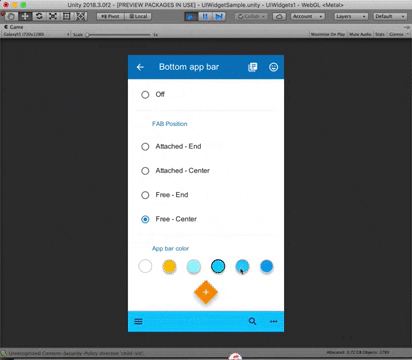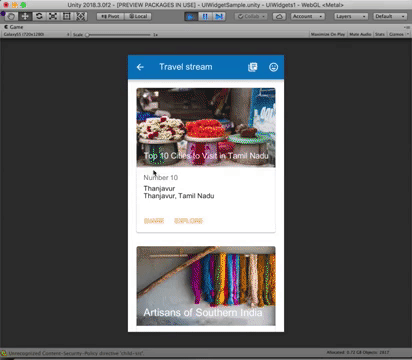UIWidgets is a plugin package for Unity Editor which helps developers to create, debug and deploy efficient, cross-platform Apps using the Unity Engine.
UIWidgets is mainly derived from Flutter. However, taking advantage of the powerful Unity Engine, it offers developers many new features to improve their Apps as well as the develop workflow significantly.
UIWidgets 2.0 is developed for Unity China version deliberately and aims to optimize the overall performance of the package. Specifically, a performance gain around 10% is observed on mobile devices like iPhone 6 after upgrading to UIWidgets 2.0.
If you still want to use the original UIWidgets 1.0, please download the archived packages from Releases or switch your working branch to uiwidgets_1.0.
Using the latest Unity rendering SDKs, a UIWidgets App can run very fast and keep >60fps in most times.
A UIWidgets App can be deployed on all kinds of platforms including PCs and mobile devices directly, like any other Unity projects.
Except for basic 2D UIs, developers are also able to include 3D Models, audios, particle-systems to their UIWidgets Apps.
A UIWidgets App can be debug in the Unity Editor directly with many advanced tools like CPU/GPU Profiling, FPS Profiling.
The Unity Connect App is created using UIWidgets 2.0 and available for both Android (https://unity.cn/connectApp/download) and iOS (Searching for "Unity Connect" in App Store). This project is open-sourced @https://github.com/UnityTech/ConnectAppCN.
The official website of Unity Chinese Documentation (https://connect.unity.com/doc) is powered by UIWidgets 1.0 and open-sourced @https://github.com/UnityTech/DocCN.
Specifically, the compatible Unity versions for each UIWidgets release are listed below. You can download the latest Unity on https://unity.cn/releases.
| UIWidgets version | Unity 2019 LTS | Unity 2020 LTS |
|---|---|---|
| 1.5.4 and below | 2019.4.10f1 and above | N\A |
| 2.0.1 | 2019.4.26f1c1 | N\A |
| 2.0.3 | 2019.4.26f1c1 ~ 2019.4.29f1c1 | N\A |
| 2.0.4 and above | 2019.4.26f1c1 ~ 2019.4.29f1c1 | 2020.3.24f1c2 and above |
Visit our Github repository https://github.com/Unity-Technologies/com.unity.uiwidgets to download the latest UIWidgets package.
Move the downloaded package folder into the Package folder of your Unity project.
Generally, you can make it using a console (or terminal) application by just a few commands as below:
cd <YourPackagePath>
git clone https://github.com/Unity-Technologies/com.unity.uiwidgets.git com.unity.uiwidgets
Note that there are many native libraries we built for UIWidget 2.0 to boost its performance, which are large files and hosted by Git Large File Storage. You need to install this service first and then use it to fetch these libraries.
Finally, in PackageManger of unity, select add local file. select package.json under /com.unity.uiwidgets
In this tutorial, we will create a very simple UIWidgets App as the kick-starter. The app contains only a text label and a button. The text label will count the times of clicks upon the button.
First of all, please open or create a Unity Project and open it with Unity Editor.
A UIWidgets App is usually built upon a Unity UI Canvas. Please follow the steps to create a UI Canvas in Unity.
- Create a new Scene by "File -> New Scene";
- Create a UI Canvas in the scene by "GameObject -> UI -> Canvas";
- Add a Panel (i.e., Panel 1) to the UI Canvas by right click on the Canvas and select "UI -> Panel". Then remove the Image Component from the Panel.
A UIWidgets App is written in C# Scripts. Please follow the steps to create an App and play it in Unity Editor.
-
Create a new C# Script named "UIWidgetsExample.cs" and paste the following codes into it.
using System.Collections.Generic; using uiwidgets; using Unity.UIWidgets.cupertino; using Unity.UIWidgets.engine; using Unity.UIWidgets.ui; using Unity.UIWidgets.widgets; using Text = Unity.UIWidgets.widgets.Text; using ui_ = Unity.UIWidgets.widgets.ui_; using TextStyle = Unity.UIWidgets.painting.TextStyle; namespace UIWidgetsSample { public class UIWidgetsExample : UIWidgetsPanel { protected void OnEnable() { // if you want to use your own font or font icons. // AddFont("Material Icons", new List<string> {"MaterialIcons-Regular.ttf"}, new List<int> {0}); base.OnEnable(); } protected override void main() { ui_.runApp(new MyApp()); } class MyApp : StatelessWidget { public override Widget build(BuildContext context) { return new CupertinoApp( home: new CounterApp() ); } } } internal class CounterApp : StatefulWidget { public override State createState() { return new CountDemoState(); } } internal class CountDemoState : State<CounterApp> { private int count = 0; public override Widget build(BuildContext context) { return new Container( color: Color.fromARGB(255, 255, 0, 0), child: new Column(children: new List<Widget>() { new Text($"count: {count}", style: new TextStyle(color: Color.fromARGB(255, 0 ,0 ,255))), new CupertinoButton( onPressed: () => { setState(() => { count++; }); }, child: new Container( color: Color.fromARGB(255,0 , 255, 0), width: 100, height: 40 ) ), } ) ); } } }
-
Save this script and attach it to Panel 1 as its component.
-
Press the "Play" Button to start the App in Unity Editor.
Finally, the UIWidgets App can be built to packages for any specific platform by the following steps.
- Open the Build Settings Panel by "File -> Build Settings..."
- Choose a target platform and click "Build". Then the Unity Editor will automatically assemble all relevant resources and generate the final App package.
- Put your images files in StreamingAssets folder. e.g. image1.png.
- Use Image.file("image1.png") to load the image.
UIWidgets supports Gif as well!
- Put your gif files in StreamingAssets folder. e.g. loading1.gif.
- Use Image.file("loading1.gif") to load the gif images.
Status bar is always hidden by default when an Unity project is running on an Android device.
If you
want to show the status bar in your App, you can disableStart in fullscreen and record outside safe area, make sure showStatusBar is true under UIWidgetsAndroidConfiguration
Please put images under StreamingAssets folder, a and loading it using Image.file.
By setting UIWidgetsGlobalConfiguration.EnableAutoAdjustFramerate = true in your project, UIWidgets will drop the frame rate of your App to 0 if the UI contents of UIWidgetsPanel is not changed for some time. This will help to prevent battery drain on mobile devices significantly. Note that this feature is disabled by default.
Long time garbage collection may cause App to stuck frequently. You can enable incremental garbage collection to avoid it. You can enable this feature by setting UIWidgetsGlobalConfiguration.EnableIncrementalGC = true, and enabling Project Setting -> Player -> Other Settings -> Use incremental GC.
In the Editor, you can switch debug/release mode by “UIWidgets->EnableDebug”.
In the Player, the debug/development build will enable debug mode. The release build will disable debug mode automatically.
If you see the error AssertionError: Window.instance is null or null pointer error of Window.instance,
it means the code is not running in the window scope. In this case, you can enclose your code
with window scope as below:
using(Isolate.getScope(the isolate of your App)) {
// code dealing with UIWidgets,
// e.g. setState(() => {....})
}This is needed if the code is in methods
not invoked by UIWidgets. For example, if the code is in completed callback of UnityWebRequest,
you need to enclose them with window scope.
Please see our HttpRequestSample for detail.
For callback/event handler methods from UIWidgets (e.g Widget.build, State.initState...), you don't need do
it yourself, since the framework ensure it's in window scope.
You can find many UIWidgets sample projects on Github, which cover different aspects and provide you learning materials in various levels:
- UIWidgetsSamples (https://github.com/Unity-Technologies/com.unity.uiwidgets). These samples are developed by the dev team in order to illustrates all the features of UIWidgets. you can find all the sample scenes under the Scene folder. You can also try UIWidgets-based Editor windows by clicking the new UIWidgetsTests tab on the main menu and open one of the dropdown samples.
- awesome-UIWidgets by Liangxie (https://github.com/liangxiegame/awesome-uiwidgets). This Repo contains lots of UIWidget demo apps and third-party applications.
- ConnectApp (https://github.com/UnityTech/ConnectAppCN). This is an online, open-source UIWidget-based App developed by the dev team. If you are making your own App with UIWidgets, this project will provides you with many best practice cases.
The develop team is still working on the UIWidgets Wiki. However, since UIWidgets is mainly derived from Flutter, you can refer to Flutter Wiki to access detailed descriptions of UIWidgets APIs from those of their Flutter counterparts. Meanwhile, you can join our discussion channel to keep in touch with the community.
-
The editor crashes when openning a UIWidgets 2.0 project, e.g., the Sample projects.
Please make sure that you are using campatible Unity versions to the specific UIWidgets version. For example, UIWidgets 2.0.3 is only supported on Unity China version between 2019.4.26f1c1 and 2019.4.29f1c1. You can find the detailed information in this section.
-
After openning a UIWidgets 2.0 project I receive an error DllNotFoundException: libUIWidgets.
Please make sure that the native libraries are correctly downloaded to your project. You can find them under UIWidgetsPackageRoot/Runtime/Plugins. For example, the libUIWidgets.dll under the sub folder X86_64 is the native library for Windows and the libUIWidgets.dylib under osx is for Mac.
If the libraries are not there or their sizes are small (<1MB), please ensure that you have installed Git Large File Storage in your computer and then try the following command line inside the UIWidgets repository.
git lfs pull -
What is the difference between UIWidgets 2.0 and UIWidgets 1.0 ?
In UIWidgets 1.0 we used Unity Graphics API for the rendering and all rendering codes are writen in C#. Therefore it is able to run freely on all platforms that Unity supports but relatively slow. The rendering result is also not exactly the same as in flutter due to the difference between the Unity rendering engine and flutter engine.
In UIWidgets 2.0, we wrapped the flutter engine inside a native library which is writen in C++ and used it to render on Unity Textures. Its rendering result is the same as in flutter and the performance is also better. However, in order to ensure that the flutter engine works properly along with Unity, we modified both the flutter and Unity Engine. As the result, currently UIWidgets 2.0 can only run on specific Unity versions, i.e., Unity China version and supports only part of the build targets of Unity.
For better rendering result, performance and continuous upgrade and support, you are always suggested to use UIWidgets 2.0 for your project. Use UIWidgets 1.0 only if you need to support specific target platforms like webgl.
-
I encountered with a link error with OpenGLES for iOS build using UIWidgets 2.0 with Unity 2020.3LTS.
This is caused by Unity because it removed the dependency on OpenGLES library on Unity 2020.3. To fix this issue, please open the XCode project and manually add the OpenGLES library to the UnityFramework target.
Check CONTRIBUTING.md



